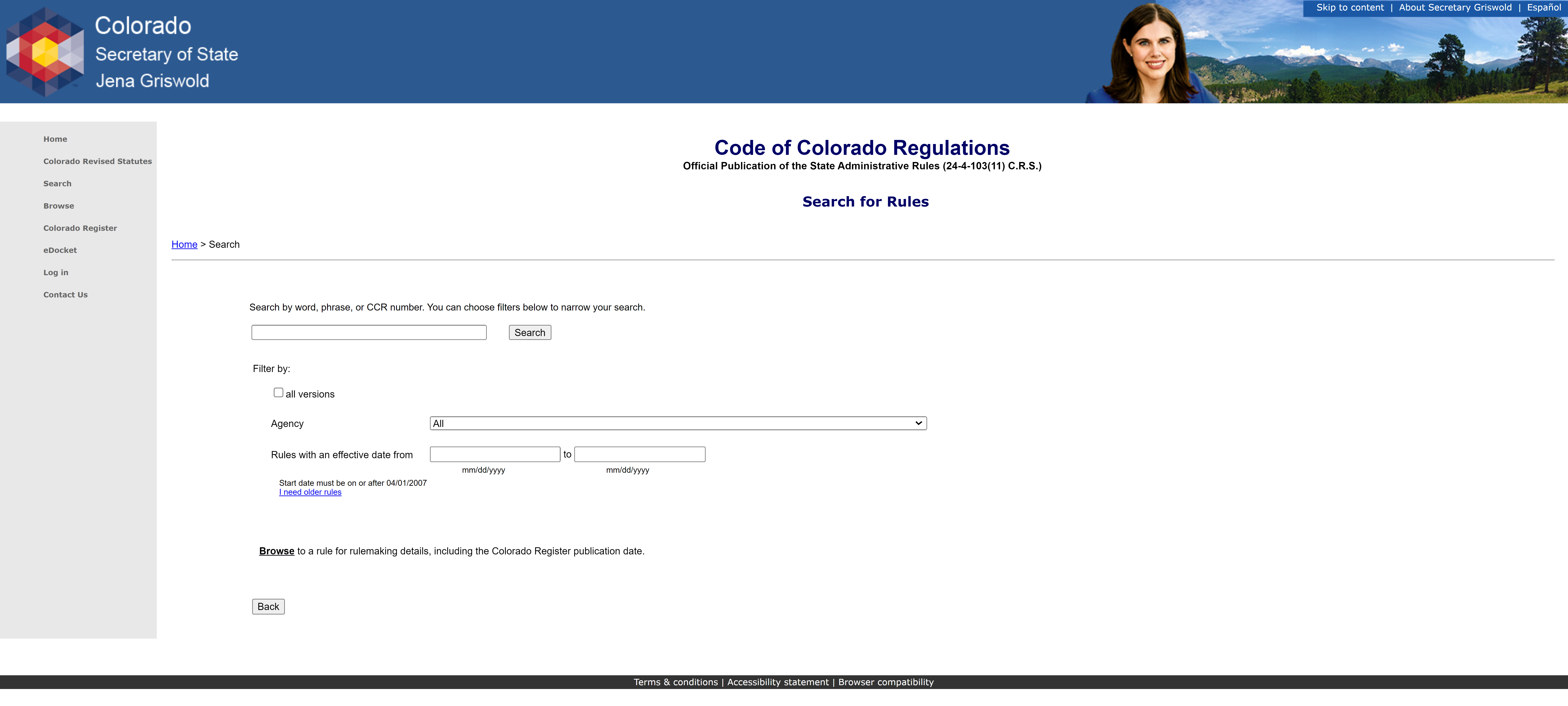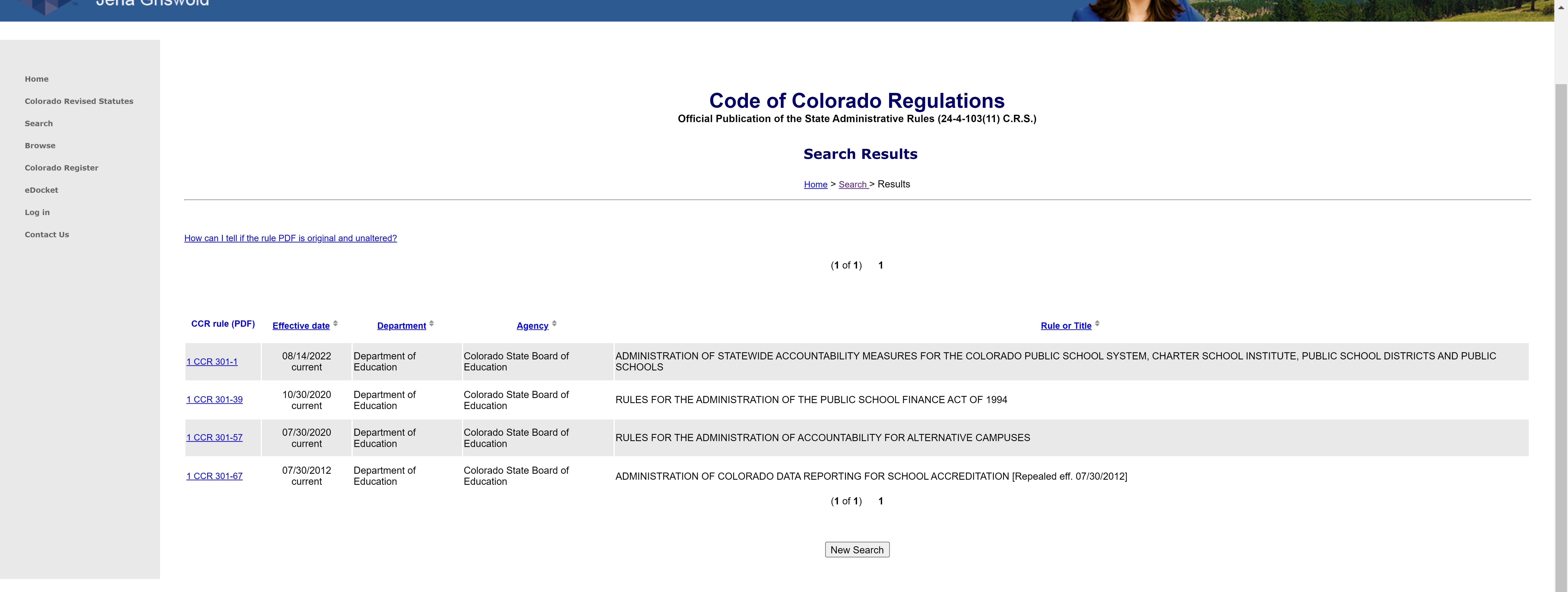
Researching Colorado Regulations
November 2023
Download This Article (.pdf)
When conducting legal research, the focus is often on locating primary law in the form of statutes enacted by the legislature and case law issued by the courts. However, there are other types of primary law issued by other governmental entities. In particular, the executive branch issues law in the form of rules and regulations and administrative decisions. Because the Colorado executive branch consists of over 100 agencies organized under 20 primary executive departments, researching administrative law in the state can be complicated. It’s helpful to understand the statutory requirements for rulemaking and the historical publication requirements of the rules. This article provides an overview of rulemaking authority, the rulemaking requirements defined by the State Administrative Procedure Act (State APA)1, the publication history of the rules, and descriptions of how to locate current and proposed rules and regulations. Researching regulatory history in Colorado will be covered in a forthcoming article.
Rulemaking Authority and the State Administrative Procedure Act
Article III of the Colorado Constitution provides that the “powers of the government of this state are divided into three distinct departments—the legislative, executive and judicial” and that those powers are to be exercised solely by the departments to which they belong. The power vested in the executive branch is to “take care that the laws be faithfully executed,” and the legislative power is vested in the legislature.2 Although the legislature may not delegate its legislative power, to support the executive branch in enforcing the laws enacted by the legislature, it may create agencies and grant rulemaking authority to those agencies.3
In Colorado, a “rule” is defined as “the whole or any part of every agency statement of general applicability and future effect implementing, interpreting, or declaring law or policy or setting forth the procedure or practice requirements of any agency. ‘Rule’ includes ‘regulation.’”4
When the legislature grants rulemaking authority to an agency, it does so in the form of an enabling statute, which grants and limits the agency’s rulemaking authority to address specific policies.5 Typically the enabling statute for a given agency is included with the statutes creating that agency. To determine if the legislature has granted rulemaking authority to an agency, you can review the statutes creating the agency or you can review the “Grants of Rulemaking Authority” table located in the Tables volume of the Colorado Revised Statutes.

This table provides a list of agencies with rulemaking authority and citations to the enabling statutes defining that authority. The table is useful for both determining if an agency has rulemaking authority and identifying many of the agencies that exist in Colorado. The table does not include agencies that do not have rulemaking authority, but there is a directory of all state agencies with their contact information available on the state’s website.6
The State APA was first adopted in 1959, born from a need to uniformly regulate the administrative procedures of the state’s various agencies.7 Many agencies were granted rulemaking authority prior to the adoption of the State APA; however, the statutes were often inconsistent or silent as to the required procedure regarding an agency’s administrative powers.8 The State APA established a required timeline and rulemaking process that applies to all state agencies within the executive branch, unless explicitly exempted.9 The procedure, as defined by the State APA, includes the following requirements: notice of proposed rulemaking, a public comment period, a public hearing, review of the final adopted rule by the Attorney General’s Office, and publication of the final rule.10 Exceptions are provided for the adoption of emergency rules, but even emergency rules must ultimately undergo the same process before they can be deemed permanent.11 A rulemaking timeline tutorial that breaks down the timing and requirements in the State APA mandated rulemaking process is available on the Secretary of State’s website.12
Publication History of the Rules and Regulations
There were no standard statutory requirements for the publication of administrative rules before the State APA was enacted in 1959, although some of the statutes granting rulemaking authority did specify requirements for notification and/or publication.13 Even in the absence of statutory requirements, some agencies would occasionally publish their rules in small booklets or provide notice in a variety of ways.14 However, there was a lack of consistency regarding notice and publication of adopted rules. The initial enactment of the State APA in 1959 provided the first set of general statutory requirements regarding the publication of administrative rules in Colorado. This first iteration required agencies to publish or give notice of proposed rulemaking or an adopted rule by mailing a copy to each person on their mailing list of interested persons and by maintaining a copy of the rules permanently available for public inspection at the agency’s office.15 Moreover, many of the statutes that existed before the State APA was adopted remained unamended, and some subsequent legislation even provided contradictory timing and notice requirements.16
The General Assembly first addressed the need for a centralized location of the state’s administrative rules in 1969. The 1969 amendment to the State APA provided for the creation of a “Colorado regulations register.”17 The register was “to be published by the secretary of state in the form prescribed by the committee on statute revision,” and that form was to be one in which the register could be easily updated.18 The amendment essentially called upon the Secretary of State to establish a subscription service by which interested members of the public could pay to receive the register and subsequent updates. The new provisions also specified that the Colorado Supreme Court Library be included on the register “mailing list” and that it should keep the register and all updates on permanent file for public inspection. The Colorado Supreme Court Library still has many of the files received as part of the “Colorado regulations register.” Based on what still exists in the library’s collection, it appears the “register” primarily consisted of reprinted notices of rulemaking hearings and transmittal letters between the agencies and either those offices required to review proposed and adopted rules or those offices required to receive notices.

These various letters and notices were organized by department and division, but there does not appear to any other defined structure or organization. As a result, this register was difficult to use and served more as a collection of notices rather than a true code of regulations.
Ultimately, the State APA was amended in 1977 to establish the Code of Colorado Regulations (CCR), which began publication on January 1, 1978.19 The amendment established the CCR as the official publication of the rules and regulations of the state agencies and provided that it would be updated by the publication of the Colorado Register (Register). The Register would contain all required notices of rulemaking, proposed rules, and adopted rules, serving as the update service to the CCR. Unlike the previous “regulations register,” this new provision required the Secretary of State to “cause to be published” the CCR and Register and permitted a publication agreement with a third-party publisher to do so.20
The original CCR was published as a set of looseleaf volumes (three-ring binders), and the Register was published monthly and contained all required notices and AG Opinions regarding rulemaking. The Register also included the updated pages for any changes made to the rules, along with instructions on which pages to remove and which to add to the CCR. The rules were organized by issuing department and given consecutive rule numbers. These rules could be found in volumes 1 through 12 of the original CCR and, as a result of this publication format, the citations to the rules include reference to the volume number in which the rule was located as well as its unique rule number. For example, the citation for the athletic trainer licensure rules is 4 CCR 735-1, with “735-1” being the rule number and the “4” indicating that rule 735-1 would have been located in volume 4 of the first printing of the CCR. As the rules expanded, the number of volumes in the CCR grew beyond the original 12 rules volumes, and many of the rules were shifted to new volumes. However, the citations still use the 12 rule volume numbers originally established in the first publication.
Starting in 2006, the Secretary of State undertook the task of migrating the CCR and Colorado Register to a digital format to make the rules more accessible. The resulting online version of the CCR is published on the Secretary of State’s website and became the official publication of the state administrative rules in 2007.21 Lexis continued publishing the print version of the rules even after the official version moved online, but ultimately ceased print publication in September 2019.
Finding Current Regulations
With the end of the print version of the CCR, the current regulations are only available digitally. Some of the agencies publish their rules on their websites, and Lexis and Westlaw often include access to the rules in their databases. However, the online CCR published on the Secretary of State’s website remains the official version of the rules, and it is available for free.22 There are two ways to locate rules in the online CCR: you can either search or browse, with both options provided on the CCR home page. Conducting a search in the CCR is recommended when you do not know the CCR number, department, or agency, and browsing the rules is recommended when you do.
After navigating to the search page from the CCR home page, you can search by keyword, phrase, or number, and you can filter by department/agency and effective date.23

If you do not select the option for “all versions” or filter rules by effective date, the search results will only include current rules. The search results page displays the results as a list of the rules that include the search term(s) with reference to the department, agency, and title of the rule. The results list provides the rules as links to PDF copies and does not provide a text preview indicating where the search terms appear in the results.

To review the rules for your search term, you can open the PDF for each rule in the results and perform a Ctrl + F (or Command + F) search of the document for your term or phrase. Due to this limitation, it is often easier to locate rules using the browse function, as long as you have identified the rule number, issuing department, or agency.
In addition to being an easier option for locating a rule with the number, department, or agency, browsing the rules also brings you to a screen where you can access some older versions of the rule as well as some documents in the rulemaking record.24 The browse rules page is accessible from the CCR home page and displays a list of departments followed by a breakdown of the agencies within those departments.

If you know the department, you can click on the link for that department at the top of the page to reveal the breakdown of agencies within that department. You can also perform a Ctrl + F (or Command + F) search of the page to locate the link for the specific agency. Clicking on the link for an agency will bring you to a page of that agency’s rules. One thing to note is that despite being online and no longer housed in binders, the rule citations still include the reference to the original print volume numbers as discussed above. Once you have identified the applicable rule, the rule page will provide a link to the PDF version of the current rule at the top with a table containing versions of the rule going back to 2007, as well as any documents available regarding the rulemaking record.

The Secretary of State provides an online tutorial with a walkthrough of searching and browsing the rules, as well as an overview of the other information that can be located on the CCR site.25 The tutorial is accessible from the CCR home page, directly under the links for the search and browse rules pages.
Finding Proposed Rules
Notices of proposed rulemaking are published in the Register, and the eDocket tracks the progress of all proposed rules, both of which can be accessed from the CCR site.

The Register is published on the 10th and 25th of each month and contains the notices of rulemaking activity filed within those two-week periods. Therefore, the Register should be used to review notices by date, and the eDocket should be used for locating activity by agency.
The official version of the Register is published online by the Secretary of State and can be accessed from the CCR home page.26 The Register defaults to a page with the issues from the current year organized by publication date. Rulemaking activity filed from the 1st through the 15th is included in the issue published on the 25th of that month and activity filed from the 16th through the end of the month is included in the issue published on the 10th of the next month. The issues are available either as a web version or as an authenticated PDF file. Although the page defaults to the current year, you can access issues of the Register back to September 2006 by selecting the desired year from the “back issues” dropdown menu at the upper right corner of the page. Note that the authenticated PDF versions only go back to 2014. There is no search feature for the Register; it is solely organized by date. However, the Register does offer an email notification service, which will provide an email alert whenever notices of rulemaking, permanent rules, or emergency rules have been published in the Register. This service allows users to designate specific agencies of interest, so the user will only receive future notices of rulemaking activity for those designated agencies.
The CCR home page also provides access to the eDocket, which is a log of agency rulemaking filings.27 The eDocket is the best option to find out if an agency has initiated any rulemaking activity and find documents related to that rulemaking. You can search the eDocket by tracking number or by agency name and date range. If there is any rulemaking activity from the designated agency and date range, the results page will list them organized by tracking number. The results provide an overview of the type of filing and what steps in the State APA rulemaking process have been completed and when.

More details regarding the rulemaking activity are found on the details page, which is accessed by clicking on the tracking number. The details page contains a “proposed rule” section that includes a PDF copy of the proposed rule, the purpose of the proposed rule, information regarding the public rule hearing, and agency contact information. If the rule has already been adopted, that information will appear at the bottom of the details page. The “adopted rule” section typically includes access to the adopted rules, a redline version of the changes, the related Attorney General Opinion, and the Colorado Register publication date for the adopted rule.
Finding Historic Rules
Because the online CCR was first published in 2007, all versions of the rules from April 2007 to the current are available on that site. The versions going back to 2007 are located on the rules page that can be located by browsing the rules on the CCR. Finding historic (pre-2007) versions of the rules is much more complicated and will be covered in a follow-up article on researching regulatory history.
Conclusion
The official publication of the state’s current and proposed rules and regulations is the online CCR, published on the Colorado Secretary of State’s website. In navigating the online CCR to find rules and regulations, it’s helpful to understand the rulemaking and rules publications requirements. In addition to the information provided in this article, you can review the Secretary of State’s tutorials on the rulemaking timeline and on using the online CCR, or reach out to your local law librarian.
Related Topics
Notes
1. CRS § 24-4-101.
2. Colo. Const. art. IV, § 2, art. V., § 1.
3. See Colo. Auto & Truck Wreckers Ass’n v. Dep’t of Revenue, 618 P.2d 646, 651 (Colo. 1980).
4. CRS § 24-4-102(15).
5. See CRS § 24-4-103(8)(a).
6. Colorado Official State Web Portal, “Contact Us,” https://www.colorado.gov/contact-us.
7. Ch. 37, 1959 Colo. Sess. Laws 158. See Henry, “The Colorado Administrative Procedure Act: Exclusions Demanding Reform,” 44 Denv. L.J. 42 (1967)
8. See, e.g., CRS 1953 §§ 129-1-4 (rulemaking authority regarding boxing and wrestling granted to the State Athletic Commission without defining rulemaking procedures); 129-2-4 (rulemaking authority regarding racing granted to the State Athletic Commission without defining rulemaking procedures); 129-2-4 (granting rulemaking authority to the Board of Examiners of Barbers and requiring rules to be posted in the office of the board for public inspection).
9. CRS § 24-4-103.
10. Id.
11. CRS § 24-4-103(6)(a).
12. Colorado Secretary of State, “Rulemaking Timeline,” https://www.sos.state.co.us/pubs/info_center/eLearningCourses/RulemakingTimeline/index.html.
13. See, e.g., supra note 8.
14. See, e.g., Colorado State Athletic Commission, Laws, Rules, and Regulations Governing Professional Boxing, Amateur Boxing, and Wrestling (1954) (available in the Colorado State Publications Library at https://athena.cde.state.co.us/record=b1023035~S1).
15. Ch. 37, § 2(10), 1959 Colo. Sess. Laws 158, 161.
16. See Henry, supra note 7 at 55–56.
17. CRS 1963 § 3-16-2(11)(a) (1969 Perm. Cum. Supp.) (added by Ch. 33, § 3, 1969 Colo. Sess. Laws 81).
18. Id.
19. CRS 1973 § 24-4-103(11) (1977 Cum. Supp.) (added by Ch. 295, § 2, 1977 Colo. Sess. Laws 1138).
20. Id. at (11)(c).
21. CCR, https://www.sos.state.co.us/CCR/Welcome.do.
22. Id.
23. CCR, “Search for Rules,” https://www.sos.state.co.us/CCR/KeywordSearch.do.
24. CCR, “Browse Rules,” https://www.sos.state.co.us/CCR/NumericalDeptList.do.
25. CCR, “Finding Rules and Other Information,” https://www.coloradosos.gov/pubs/info_center/eLearningCourses/FindingRulesAndOtherInformation/index.html.
26. Colorado Register, https://www.sos.state.co.us/CCR/RegisterHome.do.
27. eDocket, https://www.sos.state.co.us/CCR/eDocketCriteria.do.


